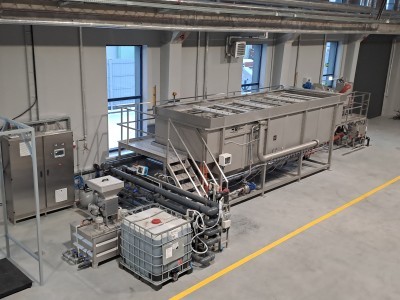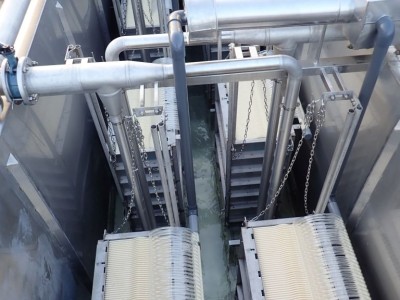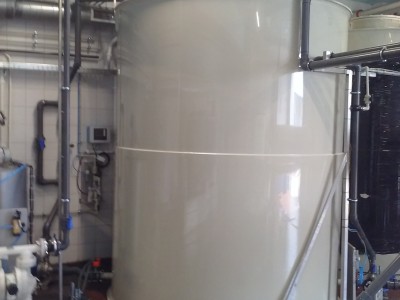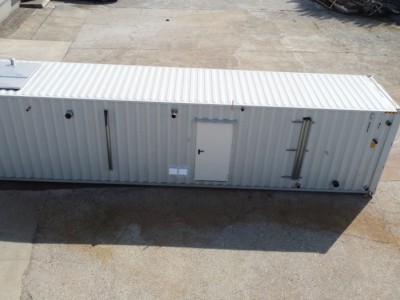Flotation is the most effective method of removing contaminants such as fats, suspensions, and petroleum substances.

Flotation is the most effective method of removing contaminants such as fats, suspensions, oil-derived substances and other undissolved substances found in industrial wastewater. The separation of these contaminants takes place in chemical processes using coagulants and flocculants (polymers). After separation, separation takes place using a water-air mixture in the flotation chamber. The resulting sludge is discharged outside the system and possibly dewatered before being disposed of, e.g. in a biogas plant.
Advanced wastewater treatment system using anaerobic processes and membrane technology.
The anaerobic biological reactor of full mixing with sludge separation in the membrane ultrafiltration system is an advanced wastewater treatment system using anaerobic processes and membrane technology. In the reactor, the wastewater is intensively mixed, which ensures even contact with anaerobic microorganisms that decompose organic matter into biogas, mainly methane and carbon dioxide. After the biodegradation process, the mixture of wastewater and sludge flows through ultrafiltration membranes. These membranes act as filters that retain solid particles, microorganisms and sludge, allowing only purified water to pass through. The purified water is discharged from the system, while the sludge is concentrated and recirculated to the reactor, which allows maintaining high microbiological activity. Ultrafiltration ensures high quality of purified water and eliminates the need for additional sludge separation processes. Thanks to the combination of intensive mixing and advanced membrane technology, this system is very efficient, stable and suitable for the treatment of wastewater with a high content of organic substances.
A modern flow reactor in which ultrafiltration membranes are responsible for the separation of sludge.

Membrane biological reactor (MBR) is an advanced wastewater treatment system that combines the process of biological decomposition with membrane filtration. In the first stage, wastewater is directed to a biological reactor, where microorganisms break down organic pollutants. Then, the mixture of wastewater and sludge flows through membranes, which act as filters, retaining solid particles and microorganisms, and allowing purified water to pass through. These membranes can be immersed directly in the reactor or placed in a separate filtration module. Thanks to the use of membranes, MBR provides high quality purified water, eliminating the need for secondary settling tanks. This system is effective in removing both organic pollutants and pathogens, so it can be used for various applications, including obtaining water of drinking water quality. MBR is characterized by a compact design and the ability to work with high sewage load, which makes it an effective and versatile solution in wastewater treatment.
Membrane processes used for wastewater and water treatment.

Ultrafiltration is a membrane process used to purify water by passing it through semipermeable membranes that block particulate matter, bacteria, and viruses. These membranes can come in a variety of shapes, such as flat-sheet and hollow-fiber. Depending on the material they are made of, the membranes can be made of polyvinylidene fluoride (PVDF) or silicon carbide (SiC). The filtration method of the membranes can be from inside to outside (inside-out) or from outside to inside (outside-in). Ultrafiltration modes can be vacuum-driven, where water is drawn through the membranes, or pressure-driven, where water is pushed through the membranes under pressure. In both modes, the membranes retain contaminants, allowing only clean water to pass through. Due to its high efficiency in removing contaminants, ultrafiltration is widely used in the treatment of drinking water, wastewater, and industrial processes.
Technology from the group of advanced oxidation processes used in special cases.

The Fenton process is an advanced oxidation method used in industrial wastewater treatment that uses chemical reactions to degrade organic contaminants. The process involves the reaction of iron (II) with hydrogen peroxide (H₂O₂) to produce powerful hydroxyl radicals (•OH). These radicals are highly reactive and effectively oxidize a wide range of organic contaminants, converting them to less harmful products or completely mineralizing them. In the Fenton process, iron acts as a catalyst, accelerating the reaction and increasing the efficiency of the process. Once the reaction is complete, the byproducts are removed or processed further, and the purified water can be subjected to further treatment steps. The Fenton process is effective in removing difficult-to-decompose contaminants such as industrial chemicals, dyes, pesticides, and some toxic substances.
EMI offers specialized containers with built-in equipment for the implementation of any industrial wastewater treatment processes.

EMI has developed modular container systems in a marine version and designed to be connected into larger systems. The containers we offer have been designed from the ground up to operate in the harsh conditions of industrial sewage treatment plants. The interiors are lined with 100% stainless steel, have heating, ventilation, health and safety devices and individually configured technological equipment. The use of container construction allows for the shortest possible project implementation time. The entire installation is prefabricated in the EMI production plant and is delivered ready for start-up immediately after connection on site (in some cases preparatory works are required, such as tanks and underground networks, ground hardening, etc.). EMI's offer also includes tanks in containers that can perform averaging, storage and even become biological reactors.